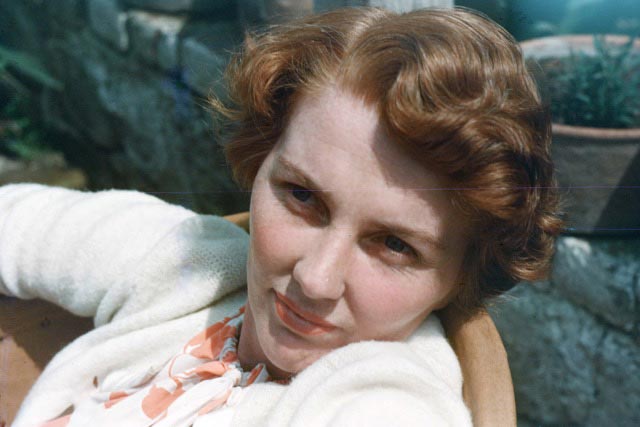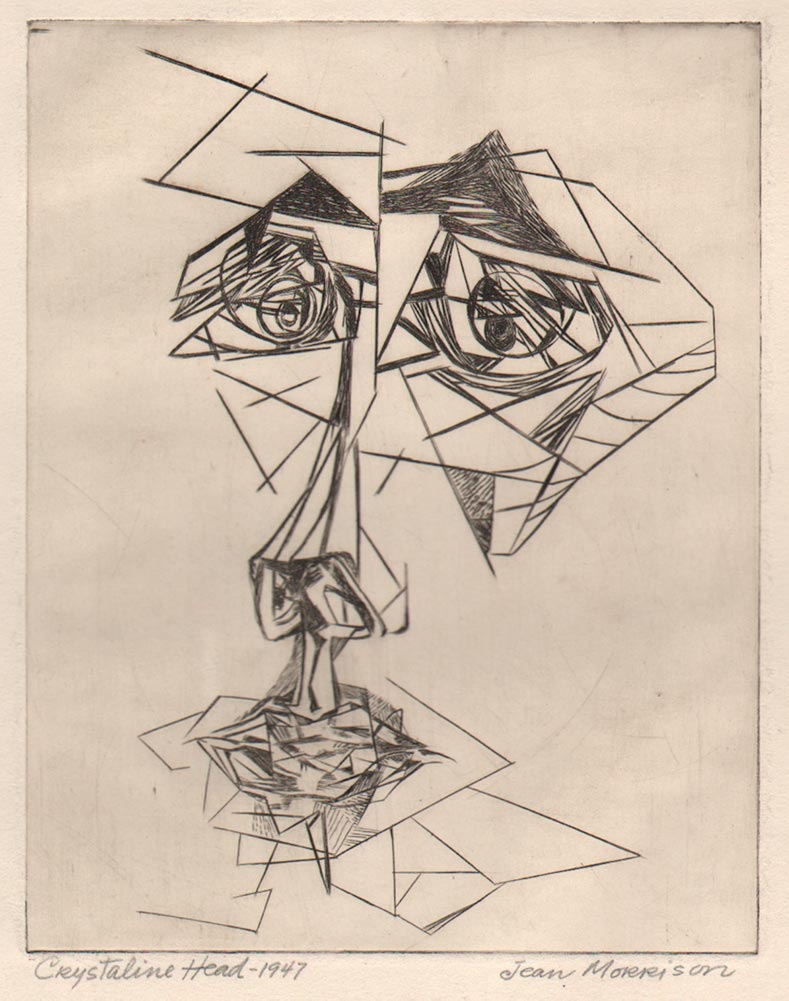62. Jean Morrison Becker
| Life Dates | 1917-1995 |
| Place of Birth | Cranford, NJ, USA |
| Place of Death | Amherst, MA, USA |
| Birth Name | Jean Morrison |
Born in Cranford, New Jersey, Jean Morrison was the middle child and only daughter of Samuel and Viola Morrison. Morrison graduated from the Vail-Dean School, a private secondary school in Elizabeth, New Jersey, and matriculated to Sarah Lawrence College, where she was enrolled between 1935 and 1938.1 There, she studied the performing and visual arts, the latter under the tutelage of Kurt Roesch.2 It was with Roesch that Morrison became fascinated with the interplay between color and line, almost at the exclusion of subject matter.3 After leaving Sarah Lawrence (she completed her bachelor’s degree in 1973), Morrison became involved in the arts scene in New York City, exhibiting at the Riverside Museum with the “Bombshell” group and organizing the “Heterous” group which showed at the Pinacotheca Gallery.4 In 1941, she spent a summer at the Colorado Springs Fine Art Center and, upon her return to the east coast, taught at the Neighborhood Settlement House in Newark, New Jersey. With America’s entry into World War II, Morrison departed in 1943 for Europe, volunteering for the American Red Cross in England and Germany. After VE Day, Morrison spent some months trying to secure art instruction in Paris—pluckily visiting Gertrude Stein without prior appointment—and also enrolled at the Slade School of Fine Art, returning to the United States in February 1946.5 Whether through Roesch or another connection, Morrison began renting a studio space in a building on 119^th^ Street and Lexington Avenue where Alice Trumbull Mason, another Atelier 17 member, had her studio. It was likely Mason or one of the building’s other studio renters—Carl Holty, Andre Racz, or Harry Hoen—encouraged Morrison to visit Atelier 17, which she did later in 1946.6 There, she used various intaglio processes to expand her work in abstraction, and her prints from this period combine human forms and architectonic structures. One such print was a pared-down, linear portrait of Fred Becker (1913-2004), an early member of Atelier 17 and trusted “right hand man” to Hayter in the development of simultaneous color printing. Morrison and Becker married in 1949 in St. Louis, where he had taken a job establishing the printmaking program at Washington University. Painting and drawing were always Morrison’s primary focus, and she actively showed this work in galleries in New York City and later in St. Louis. Morrison only produced a handful of prints, which she exhibited on a more limited scale. For many years, Morrison taught painting and design in the continuing education division of Washington University. She and Becker moved in 1968 to Amherst, Massachusetts, and Morrison grew more involved with activism, working at the Everywoman’s Center (now the Center For Women & Community) at the University of Massachusetts, Amherst, and becoming a member of the Amherst Public Art Commission.
Archives
Carla Becker, Sunderland, Mass.
Selected Bibliography
“By Groups and Singly.” New York Times, May 14, 1944.
Devree, Howard. “A Reviewer’s Notebook (The Hetero Painters).” New York Times, November 8, 1942.
Glueck, Grace. “Jean Morrison Becker, 1917-1994.” The Massachusetts Review XLV, no. 4 (Winter 2004): 665–72.
“Jean Morrison Becker.” The Amherst Bulletin, July 15, 1994.
Jean Morrison Becker. New York: Susan Teller Gallery, 2008.
“Jean Morrison Is Married to Fred G. Becker.” St. Louis Post-Dispatch, February 20, 1949.
Notes
- Published biographies and even Morrison’s own CV inaccurately date her attendance at Sarah Lawrence to 1938–41. The registrar’s records show she enrolled from September 1935 to May 1938, earning a two-year degree in 1937 and staying on for 1937–38 as a “special student.” ↩
- Kurt Roesch became affiliated with Atelier 17 shortly after Morrison left Sarah Lawrence. Interestingly, he made introductions for many other, promising Sarah Lawrence students to attend Atelier 17 and was instrumental in getting Cynthia Brants there in the mid-1940s, inaugurating years of printmaking work. ↩
- Grace Glueck, “Jean Morrison Becker, 1917-1994,” The Massachusetts Review XLV, no. 4 (Winter 2004): 665–72. ↩
- Jean Morrison Becker, curriculum vitae, ca. 1992, courtesy Carla Becker. ↩
- Morrison showed up at Gertrude Stein’s door without invitation (she merely looked up her address in the phone directory). In a letter home to her parents, Morrison wrote: “I found myself in her library discussing the problems the G.I. are facing on their return to the states. Eventually working up to my problem of painting in Paris as a civilian, she suggested that I get a job as a part time domestic and study the rest of the time. I must look a lot worse than I thought I did in this uniform. Anyway I told her I was sure there was an easier way out. She didn’t suggest as I hoped she would that Picasso was looking for students and would be glad to instruct them in exchange for cigarettes. If only Picasso spoke English we might be able to come to terms.” Jean Morrison to Samuel Morrison, December 14, 1945, courtesy Carla Becker. ↩
- According to Mason’s daughter, Emily Mason Kahn, the studio space was on the top of a garage that covered the entire block. The space was divided into three studios, and Mason’s studio shared a telephone line with the next-door studio by means of a small cutout in the wall. In 1947, Joan Miró sublet this adjoining studio from Carl Holty in order to work on his mural for the Terrance Plaza Hotel in Cincinnati, and Mason was able to peek in to see Miró’s progress. Andre Racz and Harry Hoen—and likely others—also rented studios in this building. ↩


